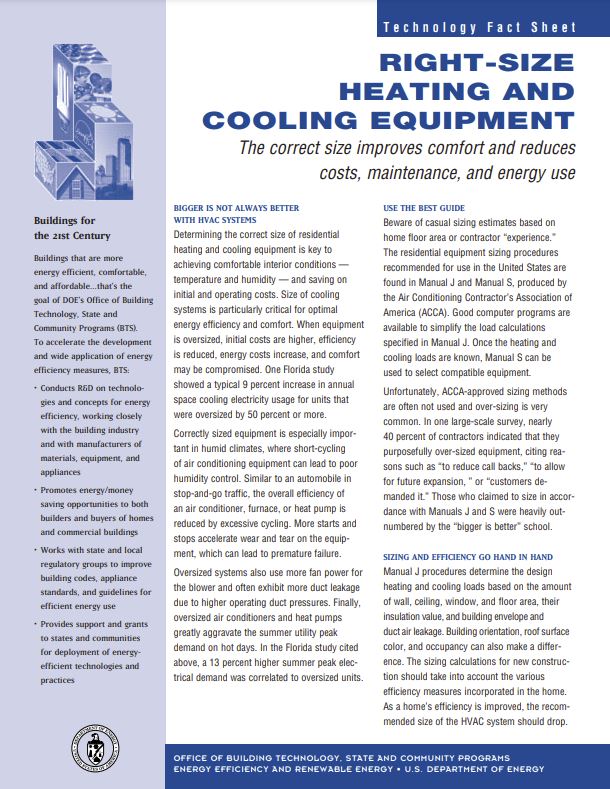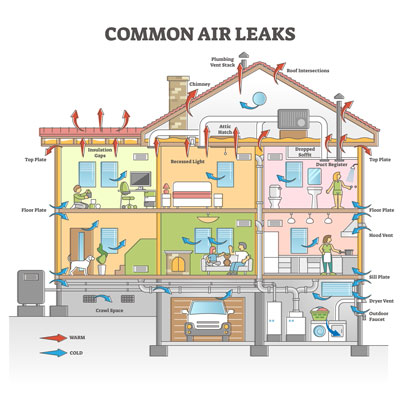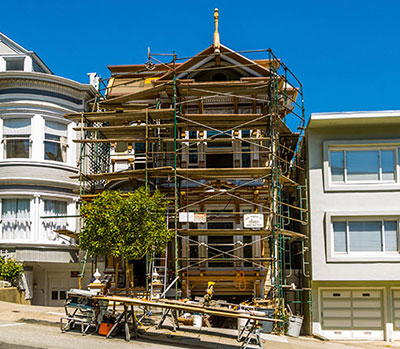
Retrofit and remodeling of an existing building provide one of the greatest opportunities to improve energy efficiency, comfort, healthiness, durability, and economy for a more sustainable building well into the future. The opportunity to achieve these benefits depends on the “depth and breadth” and the budget for a remodel or renovation project. Ultimately, it is a practical exercise of evaluating requirements, opportunities, and priorities in the planning process for a remodeling project investment.
These resources are intended to help get the most out of your remodeling project by maximizing practical retrofit opportunities that will pay dividends into the future. Many of these improvements may be hidden from view when the project is complete, but they will have a significant impact on the quality and value of your remodeling investment.
Tax Incentives for Home Improvements
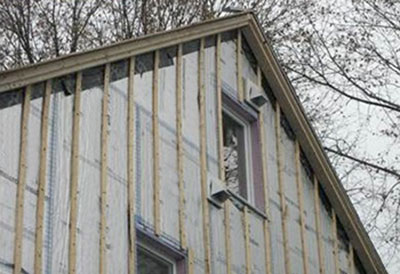
Building alterations that are often included as a part of a remodeling and retrofit project generally touch on one or more of the following building systems:
- Building Envelope (roof, walls, windows and doors, floors, and foundation)
- HVAC Equipment (heating and cooling equipment, ducts, ventilation, dehumidifiers, etc.)
- Mechanical Equipment (water heater, plumbing, fixtures, etc.)
- Electrical (lighting, EV charging, receptacles, renewable power generation, etc.)
When planning a remodeling project, the first topic we address are building code requirements. Next, we briefly review retrofit opportunities for HVAC, Mechanical, and Electrical systems that can be considered and easily integrated into most typical remodeling projects. Finally, we discuss and identify opportunities to retrofit and improve the building envelope or “shell” of a building.
A building thermal envelope that performs well is crucial to the long-term energy efficiency and durability (i.e., sustainability) of a building. It also makes a building more comfortable for occupants, more resilient to extreme weather or power outages, and better able to efficiently use renewable energy, like roof-top solar panels. Thus, when a remodeling project presents practical opportunities to improve the performance of the building envelope, they should not be missed.
Click to expand an option below for more information.
Here are model energy code requirements for existing buildings:
- 2024 IECC (Commercial) - Chapter 5 [CE] Existing Buildings
- 2024 IECC (Residential) - Chapter 5 [RE] Existing Buildings
- ASHRAE 90.1 - 2022 – Chapter 5 (building envelope insulation, fenestration, and air leakage requirements
- Proposed new 2024 IECC requirements (FSC code proposals CEPI-221-21 and REPI-150-21)
The above resources are representative of minimum energy code requirements. Local requirements should be verified, including those related to building code, zoning ordinances, and other local or community requirements. Consequently, requirements may vary in the level of completeness, stringency, and enforcement. Where feasible or practical, going “above code” with the energy efficiency features of a remodeling or replacement project may be optimal and is recommended as a best practice.
Any new construction, such as a new wall or a completely new addition, must comply with energy code requirements for new buildings even if it is part of a larger remodel or renovation project. Again, local requirements should be verified.
Replacing older, poor efficiency HVAC, mechanical, and electrical systems with newer high efficiency products is a relatively simple upgrade that can provide significant energy savings. Some examples include:
- Gas furnace (minimum 90 AFUE rating or greater)
- Heat pump (minimum 14 SEER and 8.2 HSPF rating or better)
- Air conditioner (minimum 14 SEER rating)
- Heat pump water heater
- Water-saver plumbing fixtures
- LED lighting fixtures
- Low-energy appliances (EPA Energy-star rated washer, dryer, refrigerator, etc.)
Right-sized HVAC Equipment
Be sure that your equipment is properly sized (see “right sized”) by a knowledgeable professional. When sizing equipment, more is not necessarily better. For example, an oversized heat pump or air conditioner can result in a number of problems or missed opportunities including:
- Short cycling, which reduces energy efficiency of heating and cooling the space
- Reduced effectiveness in controlling indoor humidity
- Shorter life-expectancy
- More expensive and/or larger equipment than needed
To properly size heating and cooling equipment, the insulation levels and air tightness of a building envelope must be known and verified in equipment sizing software to avoid a “garbage-in, garbage-out” result. Thus, the HVAC equipment sizing analysis must be coordinated with planned improvements or upgrades of the building envelope (or lack thereof). The better the insulation levels and control of air leakage by the building envelope, the smaller the equipment needed and the better the control of the indoor environment. Again, a good building envelope provides the foundation for optimal equipment sizing and specification.
For more information, refer to this DOE resource.
Indoor Air Quality / Healthy Buildings
Some other considerations related to HVAC system design include:
- Outdoor (fresh air) ventilation rate coordinated with the air leakage performance of the building envelope.
- Best Practice: Use a balanced air flow distribution system with an energy recovery ventilator to avoid an energy and moisture penalty for providing healthy indoor air, maximize uniformity of comfortable conditions, and minimize pressure differentials that can force moist air through building assemblies creating mold or durability problems.
- Filtration of recirculated and outdoor air to remove particulates, including viral-sized air-borne particles.
- Best Practice: Use return grilles and filters sized based on the degree of filtration targeted and the pressure drop caused by the specified filter at the design HVAC air flow rate.
For more information and guidance, refer to Healthy Buildings.
The building envelope is what separates the indoors from the outdoors and is crucial to the ability of an HVAC system (heating and cooling equipment) to do its job to maintain a healthy and comfortable indoor living environment. It determines the amount of heat gain or loss from a building, which determines the “load” or burden that the HVAC system must manage. A building with inadequate insulation and excessive air leakage (draftiness) has a significant energy and comfort penalty that cannot be fully offset by using bigger or more efficient HVAC equipment. (Click on image to enlarge.)
The opportunities to upgrade your building thermal envelope depend on what building envelope assemblies are part of or may be affected by your remodeling project. Click on the tabs below for Home Remodeling Resources or Commercial Building Remodeling Resources to learn more.
When a home is found to have a building envelope upgrade or weatherization need during a home assessment, DOE strongly recommends that those needs be met before any mechanical or appliance upgrades are considered. Check out these resources:
- Recommendations for Envelope-First, Heat Pump Ready Home Efficiency Rebate Programs
- Energy Efficient Home Improvement Credit Insulation and Air Sealing Essentials
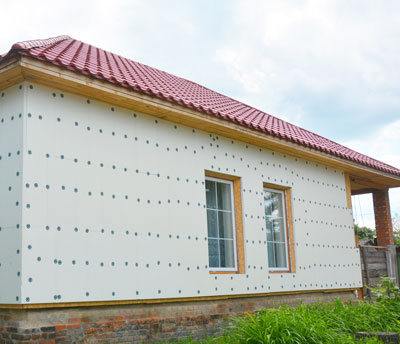
Case Studies
- Green Building Advisor Video Series: Exterior Insulation Retrofit
Learn how to wrap a house with rigid-foam insulation for big gains in energy efficiency and comfort. - Home Retrofit Results In Net Positive Energy Operation
A home in a cold climate achieved more than 85% energy and cost consumption reductions after a retrofit reduced loads and shifted its primary energy source to solar. - Comprehensive Energy Retrofit: Consortium for Advanced Residential Buildings (CARB)
The whole-building approach was followed in retrofitting this 145-year-old house in Washington, D.C.’s Capitol Hill district. - Evaluation of a Multifamily Retrofit in Climate Zone 5
In 2009, a 37-unit apartment complex located in Boulder, Colorado, underwent an energy retrofit to comply with Boulder SmartRegs Ordinance, a mandate that required all rental properties to meet certain energy efficiency standards by 2018. This case study evaluates the effectiveness of a collection of retrofit measures. - Building Science Corporation - Designs That Work (DTW)
Search this collection of case studies by topic, title, keyword, and climate zone. - Remodeling for Energy Efficiency
Can a 150-year-old house approach net-zero energy use? Three case studies point the way from the 19th to the 21st century.
Attic Remodel / Conversion to Living Space
Basement Remodel / Conversion to Living Space
- Quick Guide: Basement Wall Retrofit with FPIS ci
- Info-511: Basement Insulation
- BA-1003: Building America Special Research Project—High-R Foundations Case Study Analysis
Siding and Window Replacement
- Fitting New Windows in a Crooked Old House
- The Best Value Guide to Exterior Home Retrofits
- Adding Insulation with Re-Siding (AIRS)
- PNNL Report Residential Facade Upgrades: Market Assessment and Recommendations
- Is Adding Exterior Insulation When Re-siding Your Home Worth the Cost?
- Videos:
- Quick Guides:
Converting Cold/Damp Crawlspace to Conditioned Crawlspace
Other Resources
- Four Square Revisited Toward Zero Energy Renovation
- Weatherization Job Aids for Retrofit Installer Technicians (DOE)
- Rigid Foam Insulation for Existing Exterior Walls (Building America Solution Center)
- 2022 Study Shows Insulation Upgrades Yield Massive Returns
- Building with the Power of Plastics Infographic
- Wall Calculators - Use these tools to properly size the retro-fit exterior insulation for moisture control and energy code compliance based on the existing building’s steel or wood wall construction and climate zone location.
- ANSI/ABTG FS200.1 - 2022: Standard for Use of Foam Plastic Insulating Sheathing (FPIS) in Building Envelopes: Above-grade Walls
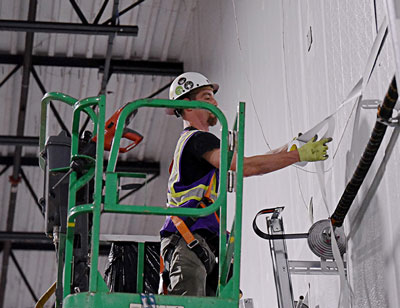 Case Studies
Case Studies
- Interior Re-Finish and Insulation of Concrete/Masonry Walls:
Other Resources
- U.S. Department of Energy - Advanced Energy Retrofit Guides (AERG) - The Advanced Energy Retrofit Guides (AERGs) were created to help decision makers plan, design, and implement energy improvement projects in their facilities. With energy managers in mind, they present practical guidance for kick-starting the process and maintaining momentum throughout the project life cycle. These guides are primarily reference documents, allowing energy managers to consult the particular sections that address the most pertinent topics. They cover five types of commercial buildings:
- Wall Calculators - Use these tools to properly size the retro-fit exterior insulation for moisture control and energy code compliance based on the existing building’s steel or wood wall construction and climate zone location.
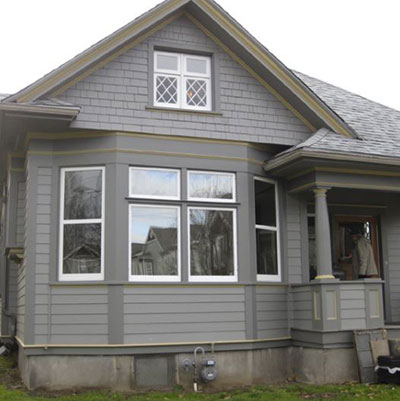
Case Studies
- Deep Energy Retrofit in the Pacific Northwest
This one-and-a-half-story, two-bedroom home with a half-basement in Portland, OR had no insulation, an unfinished basement, old appliances and air leaks everywhere when purchased in 2010. The owner performed a full deep energy retrofit, including air sealing and insulation exterior walls and attic and installing new, efficient appliances. - Remodeling for Energy Efficiency
Can a 150-year-old house approach net-zero energy use? Three case studies point the way from the 19th to the 21st century. - National Grid Deep Energy Retrofit Pilot
From 2009 through 2012, National Grid conducted a pilot program to evaluate comprehensive deep energy retrofit (DER) of homes in Massachusetts and Rhode Island. Forty-two projects participated in the pilot. - Westford Modern Colonial Deep Energy Retrofit
Major renovation including partial DER of 3,955 ft2 four bedroom, two full and one half bathrooms, three stories plus a partially finished full basement in Westford, Massachusetts. - Green Building Advisor Video Series: Exterior Insulation Retrofit
Learn how to wrap a house with rigid-foam insulation for big gains in energy efficiency and comfort.
Other Resources
